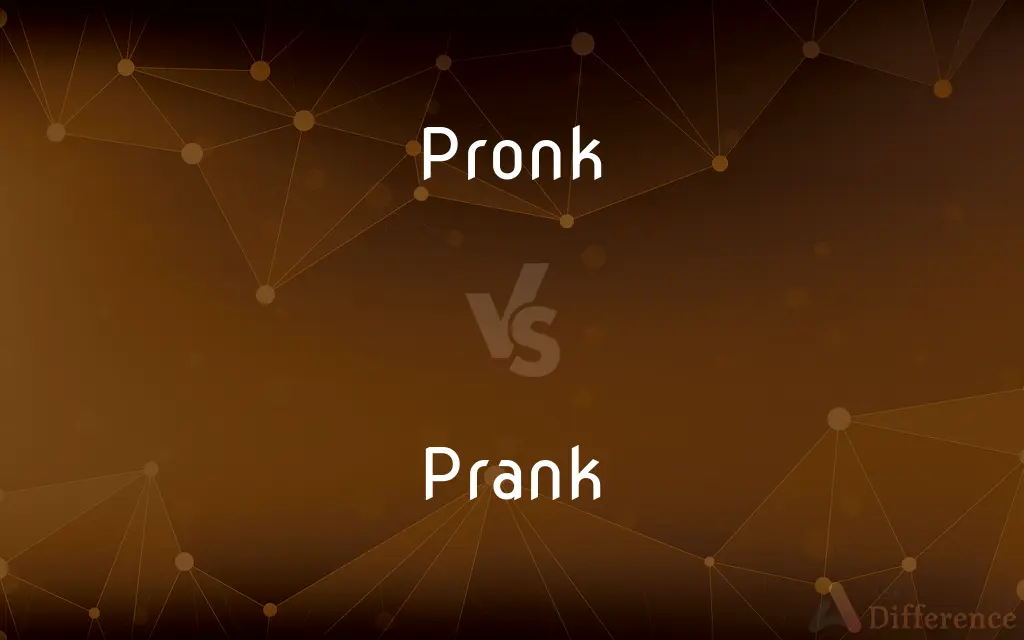Pronk vs. Prank — What's the Difference?
By Maham Liaqat & Fiza Rafique — Updated on April 8, 2024
Pronk is a behavioral display mainly observed in quadrupeds, characterized by a high, stiff-legged leap, whereas a prank is a playful or mischievous act intended to deceive or amuse.

Difference Between Pronk and Prank
Table of Contents
ADVERTISEMENT
Key Differences
Pronking, also known as stotting or pronging, is a behavior exhibited by certain quadrupeds, such as antelopes and deer, where they perform a high, stiff-legged leap. On the other hand, a prank is a human behavior involving a trick or deceit played on someone, usually in jest, without intending harm.
Pronking serves a crucial role in the survival strategies of certain animals, communicating to predators that the pronker is not an easy target. Pranks, however, are a cultural phenomenon, rooted in human creativity and the desire for social interaction.
Both pronking and pranking are forms of communication within their respective contexts. While pronking communicates through physical action, signaling health and vitality to deter predators, pranking communicates through trickery and humor, often strengthening social bonds among humans. These behaviors, although vastly different in purpose and execution, underscore the diverse ways in which living beings interact with their environment and each other.
Despite their differences, pronking and pranking both involve a degree of performance and exhibition. In pronking, the performance is for survival, while in pranking, the performance aims at creating a memorable and often humorous experience. The intentions behind each action mark the fundamental distinction between the natural instincts of animals and the complex social behaviors of humans.
Comparison Chart
Definition
High, stiff-legged leap of quadrupeds
Playful or mischievous act intended to amuse
ADVERTISEMENT
Purpose
Demonstrate fitness, deter predators
Amuse, surprise, or foster camaraderie
Context
Natural behavior in animals
Social interaction among humans
Communication
Non-verbal, instinctual
Creative, planned, often verbal
Impact
Survival mechanism
Social bonding or amusement
Compare with Definitions
Pronk
Natural Behavior.
Pronking is a natural behavior observed in various quadrupeds, especially when alarmed.
Prank
Creativity and Surprise.
Their elaborate prank on the teacher involved a surprise birthday celebration.
Pronk
Demonstrates Fitness.
Through pronking, the young antelope demonstrated its fitness to potential predators.
Prank
Playful Deception.
The classic whoopee cushion on the chair was a harmless prank that amused everyone.
Pronk
High, Stiff-legged Leap.
The gazelle pronked across the savannah, showcasing its agility.
Prank
Social Interaction.
The group often engaged in pranks to strengthen their bonds of friendship.
Pronk
Sign of Vigor.
The deer's pronk was a clear sign of its vigor and health.
Prank
Varies in Harmlessness.
The prank, while meant in good fun, inadvertently caused some confusion.
Pronk
Deters Predators.
Seeing the impala pronk, the pursuing cheetah reconsidered its attack.
Prank
Intended to Amuse.
Their prank, involving a fake lottery ticket, was designed purely for laughter.
Pronk
Pronk is a Dutch surname, which means "flamboyance" in modern Dutch or "sullen" in Middle Dutch.
Prank
A mischievous trick or practical joke.
Pronk
To leap or bound high in the air with the legs straight and the back arched, as do certain animals, especially the springbok.
Prank
To decorate or dress ostentatiously or gaudily
Was pranked up in his best suit.
Pronk
(of a quadruped) To jump with all four limbs at once.
Prank
A practical joke or mischievous trick.
He pulled a gruesome prank on his sister.
Pronk
A gait or a leap in which all four legs are used to push off the ground at once.
Prank
(obsolete) An evil deed; a malicious trick, an act of cruel deception.
Pronk
Jump straight up;
Kangaroos pronk
Prank
(transitive) To perform a practical joke on; to trick.
Prank
To call someone's phone and promptly hang up
Hey man, prank me when you wanna get picked up.
I don't have your number in my phone; can you prank me?
Prank
To adorn in a showy manner; to dress or equip ostentatiously.
Prank
(intransitive) To make an ostentatious show.
Prank
(obsolete) Full of gambols or tricks.
Prank
To adorn in a showy manner; to dress or equip ostentatiously; - often followed by up; as, to prank up the body. See Prink.
In sumptuous tire she joyed herself to prank.
Prank
To make ostentatious show.
White houses prank where once were huts.
Prank
A gay or sportive action; a ludicrous, merry, or mischievous trick; a caper; a frolic.
The harpies . . . played their accustomed pranks.
His pranks have been too broad to bear with.
Prank
Full of gambols or tricks.
Prank
Acting like a clown or buffoon
Prank
A ludicrous or grotesque act done for fun and amusement
Prank
Dress or decorate showily or gaudily;
Roses were pranking the lawn
Prank
Dress up showily;
He pranked himself out in his best clothes
Common Curiosities
What is the purpose of pronking in animals?
Pronking serves to demonstrate an animal's fitness and deter predators by highlighting its ability to perform high, energy-consuming leaps.
How are pranks usually received?
The reception of pranks largely depends on their nature; harmless pranks are often received with laughter, but pranks that cause discomfort or embarrassment can be met with mixed reactions.
Is pronking a learned behavior?
Pronking is considered an instinctual behavior in animals, likely not learned but innate, serving as a survival mechanism.
How can one respond to a prank?
Responses to a prank can vary from laughter and appreciation of the joke to setting boundaries if the prank is unwelcome or inappropriate.
Can a prank be harmful?
While most pranks are intended to be harmless and amusing, they can sometimes lead to misunderstandings, embarrassment, or even harm, depending on the nature and execution of the prank.
Do all quadrupeds pronk?
Not all quadrupeds pronk; this behavior is specific to certain species, such as gazelles, antelopes, and some species of deer, and is used as a survival tactic.
What makes a good prank?
A good prank is one that causes surprise or amusement without leading to harm, discomfort, or significant inconvenience to the person being pranked.
Can humans mimic pronking?
While humans can attempt to mimic the physical motion of pronking, the context and purpose behind the action in animals cannot be replicated by humans.
Why do people prank each other?
People prank each other for amusement, to foster camaraderie, or to celebrate certain occasions in a playful manner.
Are there any benefits to pronking for animals?
Yes, pronking can have several benefits for animals, including deterring predators by demonstrating their physical capabilities and thereby increasing their chances of survival.
Share Your Discovery

Previous Comparison
Downtempo vs. Uptempo
Next Comparison
Recorded vs. RegisteredAuthor Spotlight
Written by
Maham LiaqatCo-written by
Fiza RafiqueFiza Rafique is a skilled content writer at AskDifference.com, where she meticulously refines and enhances written pieces. Drawing from her vast editorial expertise, Fiza ensures clarity, accuracy, and precision in every article. Passionate about language, she continually seeks to elevate the quality of content for readers worldwide.
















































